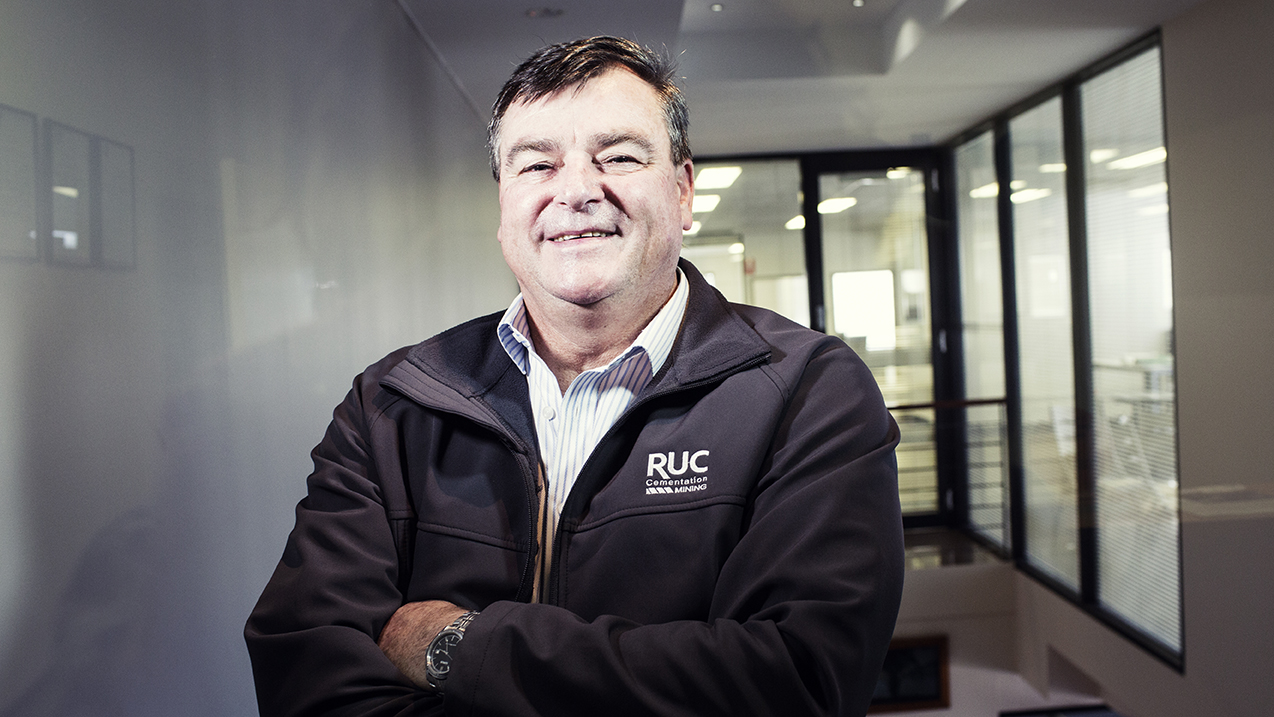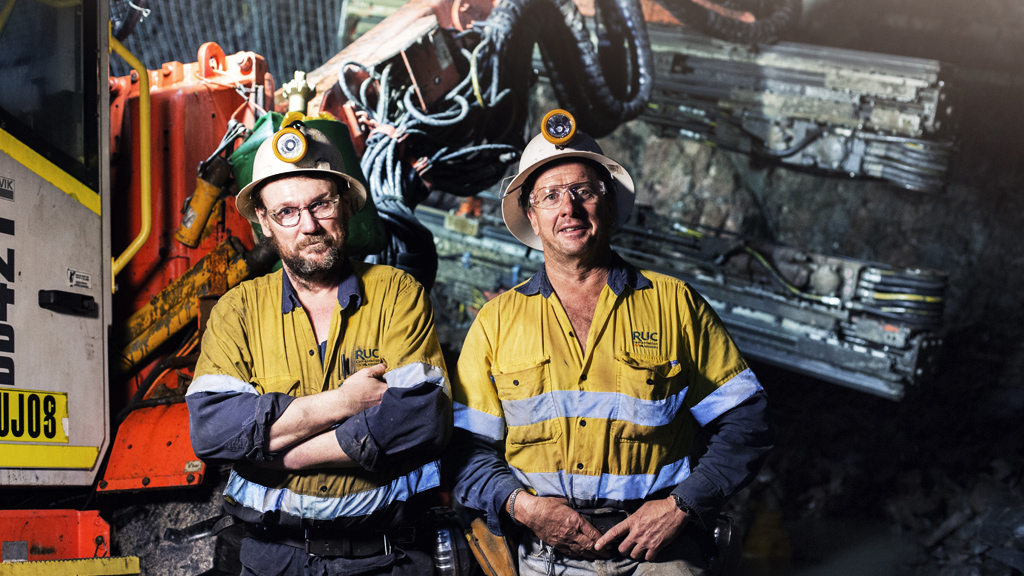Exceeding expectations
Carosue Dam, Western Australia. It’s just a few days into spring but the season’s first heatwave has already sent temperatures soaring into the low 30s Celsius. Adrian Short has to hold his feathered cowboy hat on his head as a wind gust sweeps across the arid outback landscape outside the RUC Mining office at Saracen’s Karari gold mine.
“At least the wind keeps the flies away,” quips Short, RUC’s operations manager for mechanized mining. He and his colleagues have thrived in the more controlled climate underground at Karari, where the contractor developed an exploration drill drive and main decline ahead of schedule and recently initiated underground production.
A 90-minute drive northeast of state mining hub Kalgoorlie and situated in the same prospective goldfields as some of Western Australia’s most famous deposits, Karari is being developed into a cornerstone of Saracen’s Carosue Dam Operations. RUC has been leading its transformation from open pit to underground mine since 2014, when Saracen awarded the company a contract to develop a short exploration decline. A hanging wall platform was established to facilitate an extensive underground exploration program Saracen is using to delineate and define its Karari resource.
Since the exploration decline, RUC has developed 3,500 metres in 11 months – 45 days ahead of schedule – and produced its first ore for Saracen several weeks early in August 2015.
“The strategy for RUC is to bring a product to the client, done on-time, and as safe as possible,” Short says. “If we didn’t have the equipment and the back-up we couldn’t have done that. We have the right gear, we do the job once and we don’t come back.”
The right gear
Barry Upton, a 33-year underground contract mining veteran, has served as RUC’s managing director for nearly a decade. When the contractor initiated its search for a single supplier of equipment, tools and service for the Karari project, Upton prioritized criteria in the process.
“Most people would probably say capital cost is most important in equipment selection, but I think that’s secondary or even maybe tertiary to reliability and operating cost,” he says. “Over time operating cost is far more important than your initial capital cost, and we’ve had very good operating cost and very good reliability out of the Sandvik fleet we’ve purchased for the project. You can have the best unit in the world but if there’s no service support and no reliable parts supply, then it doesn’t matter how good the unit is, it’s going to result in downtime.
“At the end of the day it comes down to cost per unit – cost per drill metre, cost per percussion hour, cost per tonne, cost per loader hour. Whatever the measure happens to be, you need to be competitive in the operating cost space, and we’ve been pleased we chose Sandvik.”
The contractor sought a versatile jumbo drill and a powerful loader to complement one another for its required development and cycle times, ultimately selecting a Sandvik DD421 twin-boom jumbo and a Sandvik LH517 loader for the project.
/https%3A%2F%2Fsolidground.sandvik%2Fwp-content%2Fuploads%2F2015%2F12%2FRUC_Karari_01.jpg)
Adrian Short, RUC’s operations manager for mechanized mining, puts the extra productivity at Karari in part down to the new Sandvik HLX125 high-frequency drifters on the Sandvik DD421 jumbo
“The loader suits the five-by-five-metre ore drives perfectly,” Upton says. “We needed flexibility to operate in a number of different size headings without compromising productivity in the larger headings. The attraction with Sandvik loaders is the power-to-weight ratio, because of the Sandvik philosophy of using a high-tensile steel frame, and the engine is attractive, both from an emissions and a technology point of view.”
A jumbo of all trades
Short navigates his light vehicle into Karari’s west portal, and soon is showing off some development recently completed ahead of schedule with the Sandvik DD421. The jumbo has delivered 30 to 40 metres a month more than the contractor expected, and Short puts the extra productivity in part down to the new Sandvik RD525 high-frequency drifters on the drill rig, which bores a 4.5-metre hole in Karari’s tough ground in two minutes.
“We can virtually do a boring cycle in around an hour and three quarters, where we actually scheduled for two and a half hours for a decline round,” he says. “That really improves our cycle times, hence we get more metres.”
In December 2015, RUC achieved a monthly record 333.7 metres of advance with the lone jumbo.
“We’ve been very pleased with the performance,” Upton says. “We’ve been looking at average availabilities of very high 80s, greater than 90 percent. Obviously the more time you’ve got your drill at the face, the quicker you’re going to advance. It’s actually close to 20 percent above our expectations when we bid the job, so it’s set a new benchmark for our company. We’re proud of our performance at Karari, both in terms of quantity and quality of the work.”
RUC uses Sandvik DD421 for several functions, including face drilling, handling mesh, installing intensive ground support and drilling long anchors. The contractor even uses the jumbo’s feed rail to move a dewatering pump at the face, which eliminates the need for people to lift in a potentially hazardous area.
“Not only did Sandvik DD421 suit us as an underground miner, it also helped satisfy our first priority, which is the safety of our employees,” Short says. “A huge part of that is the equipment we purchase has to be to the highest standards. Sandvik DD421 improves safety for us at the face and is also very fitter-friendly. Everything is serviced from the ground and nobody has to climb on the rig.”
Conscious decisions
RUC relies on Sandvik for more than just equipment, tools, parts and technical support. Sandvik even resharpens RUC’s dull drill bits at its workshop in Kalgoorlie.
“We’re getting around four to five resharps per bit, which reduces our bottom line,” Short says. “We might pay a little more up front for a quality bit, but we get a lot more out of it. We made a conscious decision to go with a single supplier of the drill rig, the loader, the drill consumables, steels, couplings, and everything.
About RUC Mining
RUC Mining is a Western Australia based underground mining contractor with an extensive portfolio of completed and current projects throughout Australia and the Asia-Pacific. A wholly-owned subsidiary of the global Murray & Roberts group, RUC Mining was established in 1990 as a shaft sinking and raise drilling specialist. Today, the company offers the full range of underground development and production services, including construction, mechanized mining, boxhole boring, large excavations and specialist ground support and grouting.
“The relationship that RUC wanted to develop with Sandvik was a long-term relationship, not just including the product. It was including the after service, which is important. If you’re a contractor, you need to have a very reputable company to supply you with tools and parts very quickly or it can turn quite disastrous, and financially it can cost you a lot of money.”
“RUC and Sandvik are partners in many senses of the word, in terms of what a partnership involves – working together to improve performance,” Upton adds. “Our partnership is healthy and strong, and that’s assisting us in delivering superior performance.”

/https%3A%2F%2Fsolidground.sandvik%2Fwp-content%2Fuploads%2F2015%2F12%2FRUC_Karari_02.jpg)
/https%3A%2F%2Fsolidground.sandvik%2Fwp-content%2Fuploads%2F2015%2F12%2FRUC_Karari_071.jpg)
/https%3A%2F%2Fsolidground.sandvik%2Fwp-content%2Fuploads%2F2015%2F12%2FRUC_Karari_05.jpg)
/https%3A%2F%2Fsolidground.sandvik%2Fwp-content%2Fuploads%2F2015%2F12%2FRUC_Karari_06.jpg)


/https%3A%2F%2Fsolidground.sandvik%2Fwp-content%2Fuploads%2F2024%2F05%2F1.jpg)
/https%3A%2F%2Fsolidground.sandvik%2Fwp-content%2Fuploads%2F2023%2F09%2FGarpenberg_1_edit-7979.jpg)
/https%3A%2F%2Fsolidground.sandvik%2Fwp-content%2Fuploads%2F2023%2F08%2F1194_2.jpg)
/https%3A%2F%2Fsolidground.sandvik%2Fwp-content%2Fuploads%2F2023%2F05%2FSandvik_electric-surface-drill-rig-concept_01.jpg)
/https%3A%2F%2Fsolidground.sandvik%2Fwp-content%2Fuploads%2F2023%2F05%2Falpha340_hex_rod_with_bit_black_2022-1.tif)
/https%3A%2F%2Fsolidground.sandvik%2Fwp-content%2Fuploads%2F2023%2F05%2Fth665b_001.jpg)
/https%3A%2F%2Fsolidground.sandvik%2Fwp-content%2Fuploads%2F2023%2F05%2FLH518iB_03437.jpg)
/https%3A%2F%2Fsolidground.sandvik%2Fwp-content%2Fuploads%2F2023%2F05%2FRecycling_Factory_Stills1_2023.jpg)
/https%3A%2F%2Fsolidground.sandvik%2Fwp-content%2Fuploads%2F2023%2F05%2Fmodule-high-res_Frilagd.png)
/https%3A%2F%2Fsolidground.sandvik%2Fwp-content%2Fuploads%2F2023%2F05%2Fimage002-1.png)
/https%3A%2F%2Fsolidground.sandvik%2Fwp-content%2Fuploads%2F2023%2F05%2FGroup-4-2.png)
/https%3A%2F%2Fsolidground.sandvik%2Fwp-content%2Fuploads%2F2023%2F05%2FImage-1-1-e1684833065132.jpeg)